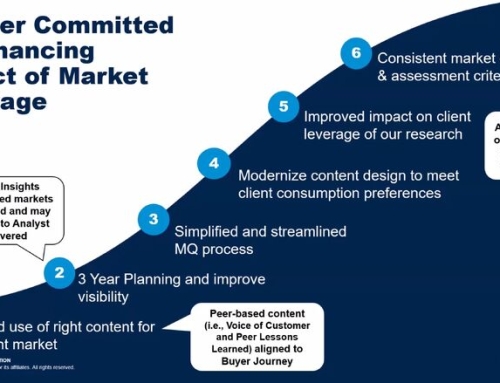Lagging in peer reviews? You might have an advantage after all.
Gartner Magic Quadrant season is in full swing. And many vendors are staring up at the mountains of competitors’ review scores on Gartner Peer Insights (GPI), wondering, “how can we climb that high in such a short time?”
With enterprise peer reviews now firmly established, vendors are fully aware of the challenge of generating reviews. But many are looking for a new strategy – because they tried asking customers for reviews before, and it didn’t work. It’s such a widespread complaint that we cover it in our Playbook.
We can offer slight consolation: any vendor coming from behind is starting with a slight advantage.
That’s because their competition went all-out to source reviews last time around. But that was then, and this is now. It’s harder for vendors to pull out all the stops in MQ season every year, although we also have a strategy for that.
We advise vendors getting to grips with GPI: Take a measured, longer game approach to source reviews. It’s more effective than a flurry of activity around the Magic Quadrant, followed by… nothing.
Why are vendors waking up to Gartner Peer Insights?
Last year, Gartner’s smart move was to shift the Voice of the Customer element of its flagship Magic Quadrant reports to Peer Insights. It has been a game-changer.
It took a while for the impact to become apparent. It’s really hitting home in the 2021 MQ cycle. A former staple of the Magic Quadrant was for vendors to send Gartner an Excel sheet with the names and numbers of their happiest, most satisfied customers. Gartner would contact them, ask them to complete a survey – and voila, the voice of the customer for an MQ.
GPI changed that. That approach is no longer accepted. Consequently, many vendors are scrambling to source GPI reviews. But they are doing so without a clear idea of how to approach customers. In some cases, they don’t even know exactly what they’re asking for.
Note: Peer Insights still isn’t a numbers game
We often see vendors taking the wrong approach in sourcing reviews by thinking of it as a numbers game. This results in frustration for vendors and customers alike, combined with a high review rejection rate. It’s not uncommon to see an initial Peer Insights rejection rate north of 40%, or even higher – and that’s on top of a low response rate. Plus, as mentioned above, many vendors are stumbling when it comes to being clear on what they’re actually asking of their customers – or why.
An unstructured approach to sourcing reviews is not a strategy. To succeed, vendors must do some essential preparation. This will dramatically improve their review yield. However, many vendors skip or overlook this, especially when they’re under time pressure.
We’re very strict in advocating a structured approach – and the results are delighting our clients. We’re enabling them to consistently lead their categories in Gartner Peer Insights.
Tell-tale signs of an immature approach
There will always be peaks around MQ season. That’s normal. However, huge spikes are signs of an immature approach to enterprise reviews. That’s why we advocate a longer-term, more planned engagement.
There are plenty of GPI review categories where you can see the remains of a hard-fought campaign to win one of the seven Customer’s Choice badges. Here, leaders often have almost impossibly high average scores – 4.8/5 is common; a 96% customer approval rating.
Side note: this has the potential to be a longer-term problem for GPI: People get the most value from critical reviews, not those full of glowing praise. It also explains why Gartner is continually purging less-helpful reviews.
In the months after Customer’s Choice winners are defined, hotly-contested categories are then somewhat neglected by vendors – until the next MQ season comes around, of course.
Then it’s time to start again – especially since the latest Gartner PI methodology reduces the weighting for reviews more than 12 months old and again on their second birthday. It’s also becoming accepted wisdom that Gartner analysts are mainly looking at reviews less than 12 months old as they conduct vendor evaluation in MQs.
Why a more strategic approach pays dividends
Three critical reasons put any vendor in a stronger position when taking a more strategic approach. First, they are sourcing new and freshened-up reviews month by month. Once the 12-month mark rolls around, their scores will not fall off a cliff. Second, a bank of relevant, fresh reviews puts them in the best starting point for a new Magic Quadrant.
The third – and most Machiavellian reason for playing the long game: it’s much harder for competitors to rally all their resources year after year in MQ season to achieve an artificially inflated or unrepresentative score. Vendors that have already gone all out for the most reviews and the best scores – driven by the incentive of the coveted Customer’s Choice badge – struggle to do it all again a year later. As a one-off, this approach can lead to a Customer’s Choice accolade. But it’s not sustainable.
Our approach helps vendors avoid making these mistakes. This avoids frustration and improves scores.
Our advice
Category leadership on Gartner Peer Insights is a long-term play. It’s exhilarating to take your category by storm and build a convincing lead – and easier to achieve when you’re playing the long game of sourcing reviews month in, month out.
If you’re a vendor heading into a Magic Quadrant with only a handful of reviews, let’s talk – we can help launch a campaign to drive reviews in time for the MQ, with the legs to keep going through the year.
On the other hand, if you’ve seen a slump in your scores after an initial campaign, talk to us. We’ll get you out of the death spiral.






